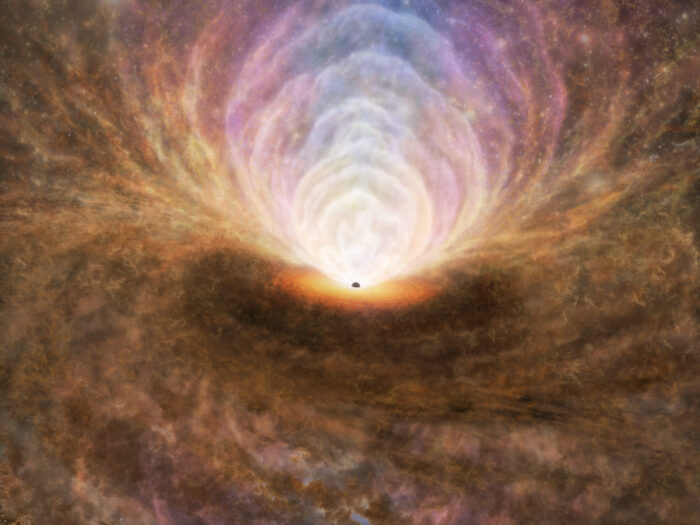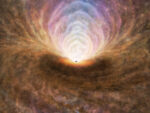ALMA Observations Unveil Gas Recycling Process Near a Supermassive Black Hole
In a scientific breakthrough, an international team of scientists has delved into the heart of the Circinus Galaxy's active galactic nucleus using the Atacama Large Millimeter/submillimeter Array (ALMA). Achieving an unprecedented resolution of about one light-year, the research, spearheaded by Assistant Professor Takuma Izumi from the National Astronomical Observatory of Japan (NAOJ), has illuminated the intricate dance of gas flows around the galaxy's supermassive black hole, encompassing plasma, atomic, and molecular phases. Notably, the team has elucidated the accretion flow—driven by a mechanism termed "gravitational instability"—that feeds the black hole. Intriguingly, not all this gas contributes to the black hole's growth. A significant fraction is ejected as atomic or molecular outflows, only to return and again be drawn towards the black hole in a cyclical pattern reminiscent of a water fountain. This profound discovery paves the way for a more holistic grasp of the growth dynamics of supermassive black holes.
At the centers of many massive galaxies, there exist "supermassive black holes" with masses exceeding a million times that of the Sun. How are these supermassive black holes formed? One of the crucial growth mechanisms proposed by previous research is "gas accretion" onto the black hole. This refers to how gas in the host galaxy somehow falls toward the central black hole.
The gas that gathers very close to supermassive black holes is accelerated at high speeds due to the gravity of the black hole. Due to intense friction between gas particles, this gas heats up to several million degrees and emits brilliant light. This phenomenon is known as an active galactic nucleus (AGN), and its brightness can sometimes surpass the combined light of all the stars in the galaxy. Interestingly, a portion of the gas that falls towards the black hole (accretion flow) is thought to be blown away by the immense energy of this active galactic nucleus, leading to outflows.
Both theoretical and observational studies have provided detailed insights into gas accretion mechanisms from the 100,000 light-year scale of the galaxies down to a scale of a few hundred light-years at the center. However, the gas accretion within a much smaller region, especially within a few dozen light-years from the galactic center, has remained unclear due to its minimal spatial scale. For instance, to quantitatively comprehend the growth of black holes, it is necessary to measure the accretion flow rate (how much gas is flowing in) and to determine the amounts and types of gases (plasma, atomic gas, molecular gas) that are expelled as outflows at that small scale. Unfortunately, observational understanding in this regard has not progressed significantly until now.
An international research team led by Takuma Izumi, an assistant professor at the National Astronomical Observatory of Japan (affiliated with NAOJ and Tokyo Metropolitan University at the time of this study), has achieved a world-first success by quantitatively measuring gas flows and their structures for all phases (plasma, atomic, and molecular) at a tiny spatial scale of just a few light-years around a supermassive black hole, by using the Atacama Large Millimeter/submillimeter Array (ALMA). Observations of multiphase gases can provide a more comprehensive understanding of the distribution and dynamics of matter around a black hole. The observed object was the Circinus Galaxy, a representative active galactic nucleus in the nearby Universe. The achieved resolution was approximately one light-year. This marks the highest resolution achieved for multiphase gas observations in an active galactic nucleus.
In this study, the research team initially succeeded in capturing, for the first time, the accretion flow heading towards the supermassive black hole within the high-density gas disk extending over several light-years from the galactic center. Identifying this accretion flow had long been a challenging task due to the small scale of the region and the complex motions of gas near the galactic center. However, in this instance, the research team pinpointed where the foreground molecular gas was absorbing the light from the background brightly shining, active galactic nucleus. This identification was made possible through high-resolution observations with ALMA. Detailed analysis revealed that this absorbing material is moving in the direction away from us. Since the absorbing material always exists between the active galactic nucleus and us, the team has successfully captured the accretion flow towards the active galactic nucleus.
Furthermore, the research team has also elucidated the physical mechanism responsible for inducing this gas accretion. The observed gas disk exhibited a gravitational force so substantial that it could not be sustained by the pressure calculated from the motion of the gas disk. When this situation arises, the gas disk collapses under its weight, forming complex structures and becoming incapable of maintaining stable motion at the galactic center. As a result, the gas rapidly falls towards the central black hole. ALMA has revealed this physical phenomenon known as "gravitational instability" at the galaxy's heart.
In addition, this study has significantly advanced the quantitative understanding of gas flows around the active galactic nucleus. The accretion rate at which gas is supplied to the black hole can be calculated from the density of the observed gas and the velocity of the accretion flow. Surprisingly, this rate was found to be 30 times greater than what is required to sustain the activity of this active galactic nucleus. In other words, most of the accretion flow at the 1-light-year scale around the galactic center was not contributing to the growth of the black hole. So, where did this surplus gas go? This study also unravels this mystery—high-sensitivity observations of all phase gases with ALMA-detected outflows from the active galactic nucleus. Quantitative analysis revealed that most of the gas that flowed toward the black hole was expelled as atomic or molecular outflows. However, due to their slow velocities, they couldn't escape from the gravitational potential of the black hole and eventually returned to the gas disk. There, they were recycled back into an accretion flow towards the black hole, akin to a fountain, thus completing a fascinating gas recycling process at the galactic center.
Regarding the achievements of this study, Takuma Izumi states, "Detecting accretion flows and outflows in a region just a few light-years around the actively growing supermassive black hole, particularly in a multiphase gas, and even deciphering the accretion mechanism itself, are indeed monumental achievements in the history of supermassive black hole research." He emphasizes the significance of this accomplishment. Looking ahead to the future, he also continues, "To comprehensively understand the growth of supermassive black holes in cosmic history, we need to investigate various types of supermassive black holes located farther away. This requires high-resolution and high-sensitivity observations, and we have high expectations for the further use of ALMA and for upcoming large radio interferometers in the next generation."
Additional information
These observation results were published by Takuma Izumi et al., "Supermassive black hole feeding and feedback observed on sub-parsec scales" in Science on November 3rd, 2023 (DOI: 10.1126/science.adf0569).
This work is supported by NAOJ ALMA Scientific Research Grant No. 2020-14A, 2022-21A, ALMA Japan Research Grant for the NAOJ ALMA Project Code NAOJ-ALMA-271, a Grant-in-Aid from the Japan Society for the Promotion of Science (JP20K14531, JP21H04496, JP17H06130, JP21K03632, JP19K03937, JP20K14529, JP20H00181, JP22H00158, JP22H01268).
The Atacama Large Millimeter/submillimeter Array (ALMA), an international astronomy facility, is a partnership of the European Organisation for Astronomical Research in the Southern Hemisphere (ESO), the U.S. National Science Foundation (NSF) and the National Institutes of Natural Sciences (NINS) of Japan in cooperation with the Republic of Chile. ALMA is funded by ESO on behalf of its Member States, by NSF in cooperation with the National Research Council of Canada (NRC) and the National Science and Technology Council (NSTC) in Taiwan and by NINS in cooperation with the Academia Sinica (AS) in Taiwan and the Korea Astronomy and Space Science Institute (KASI).
ALMA construction and operations are led by ESO on behalf of its Member States; by the National Radio Astronomy Observatory (NRAO), managed by Associated Universities, Inc. (AUI), on behalf of North America; and by the National Astronomical Observatory of Japan (NAOJ) on behalf of East Asia. The Joint ALMA Observatory (JAO) provides the unified leadership and management of the construction, commissioning and operation of ALMA.
Images


Contacts
-
Naoko Inoue
EPO officer, ALMA ProjectNational Astronomical Observatory of Japan (NAOJ)Email: [email protected] -
Bárbara Ferreira
ESO Media Manager -
Jill Malusky
Public Information Officer



